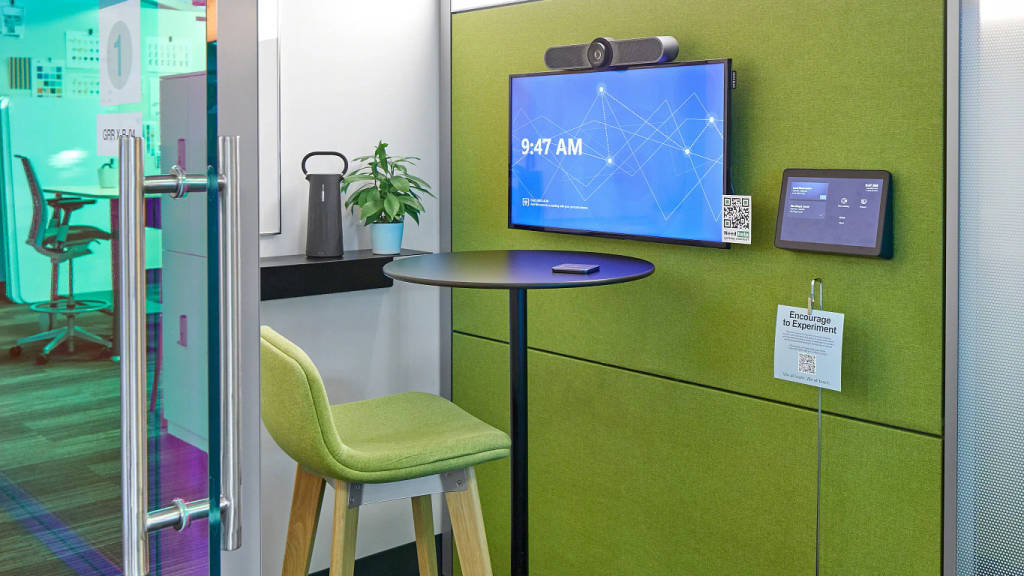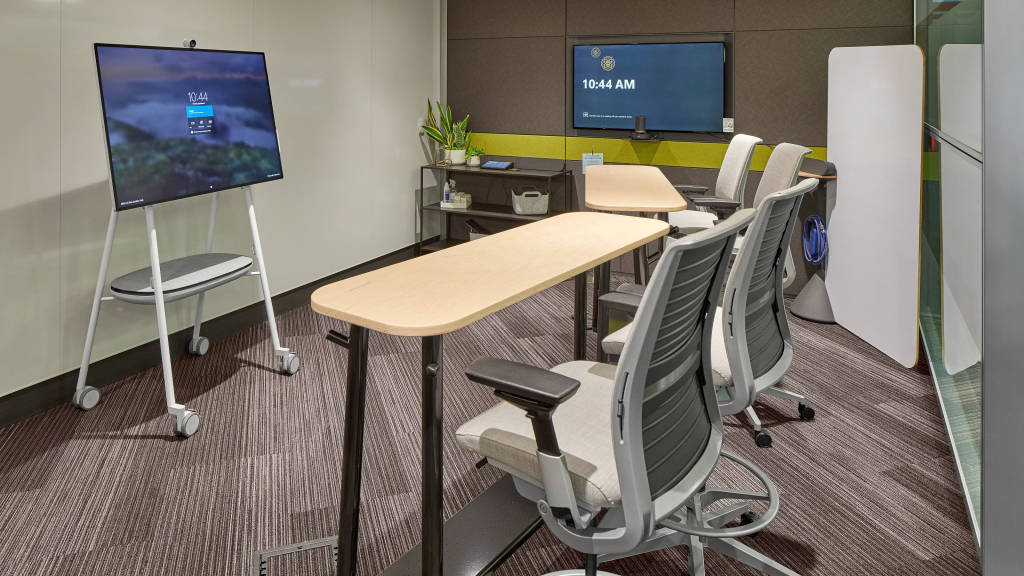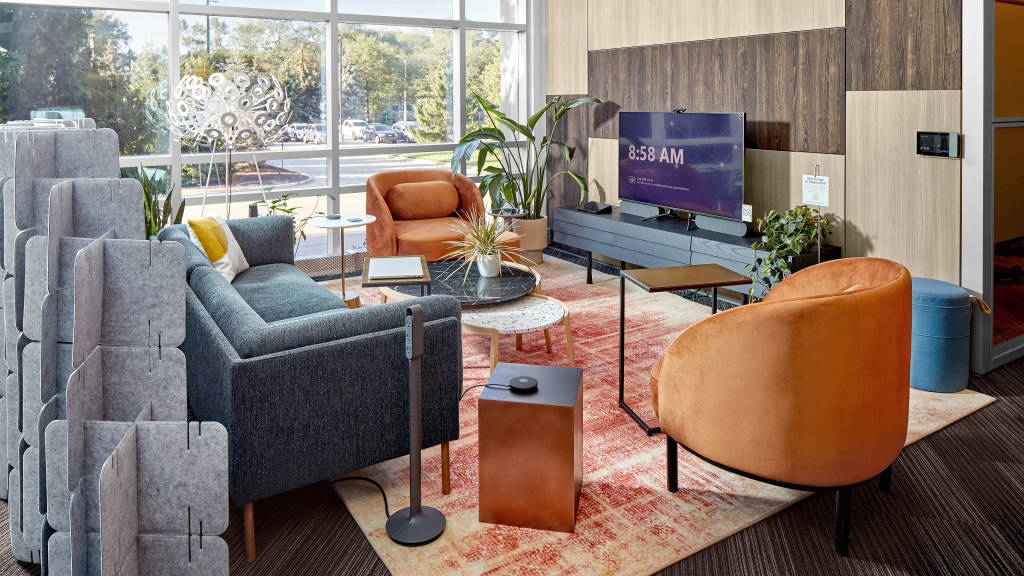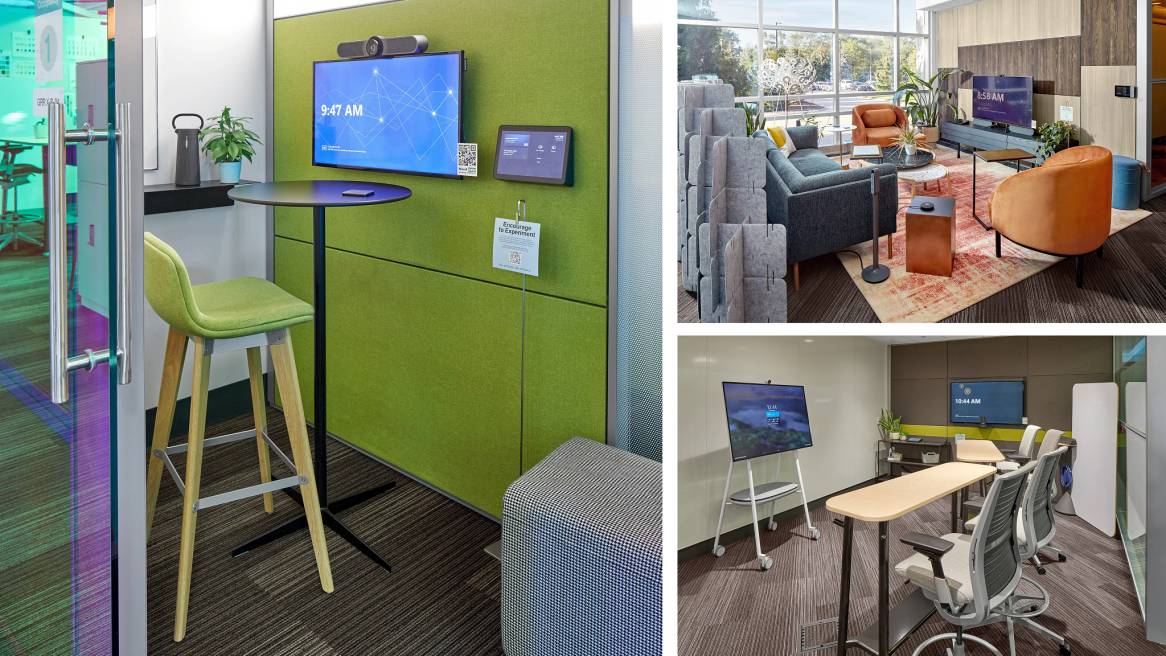Putting the Hybrid Office to the Test
See what we learned from hybrid collaboration prototype spaces.
Is your webcam too high? Too low? Is your shot too dark? Is your space too small? Too noisy? Not enough privacy? Do you sometimes feel uncomfortable delivering to a conference room full of colleagues when you’re remote?
There are reasons for that.
We know the office needs to change to support new patterns of behavior. Hybrid collaboration is an integral aspect of everyday work life for Steelcase employees at the company’s Grand Rapids, Michigan campus. Sometimes the best way to figure out what works in a space is trying and testing in real-life conditions. So, our research, design, IT and engineering teams worked with technology partners Microsoft, Zoom, and Logitech, as well as with products by Poly and custom-built solutions from BiAmp to build 12 prototype hybrid workspaces to test what worked and what didn’t.
What We Know
Based on a recent study of nearly 5,000 employees from 11 countries, Steelcase researchers found a resounding and consistent theme: People say the top two things more important in the workplace now are spaces for hybrid collaboration.
In the Steelcase Global Report, 64% say they value hybrid collaboration spaces and 62% value single-person enclaves for video calls more than they did pre-pandemic.
But, people aren’t always comfortable with the spaces where hybrid work currently happens. Whether it’s in an enclosed conference room or an open-plan individual workspace or a private office, global data suggests more than one-third of people are unsatisfied with hybrid collaboration spaces.
And surprisingly, it’s not the technology that makes people frustrated, but the spaces, noise and privacy issues that are getting in the way..
Top reasons people are not comfortable in enclosed spaces for hybrid collaboration:
47% – Space is too small
37% – Space is uncomfortable
28% – Too noisy
27% – Not enough visual privacy
19% – Difficult to reserve
15% – Lack necessary visual technology
14% – Lack necessary audio technology

Trying + Testing
Steelcase researchers wanted to address these global issues in the prototype spaces they built on the Grand Rapids campus. The dozen spaces represented a range of situations, from single-use enclosed spaces to larger enclosed and open conference spaces where hybrid collaboration takes place. As employees used the spaces, researchers noted what worked, what didn’t, and solicited feedback through QR codes, along with in-depth interviews.
Researchers wanted to understand how each space measured up to three key design objectives: equity (equal experiences for both sides of the camera), engagement (the ability to participate and contribute) and ease (seamless flow between different types of work and experiences).

Keith Bujak, Ph.D. , Steelcase research principial
“Designing spaces for hybrid work requires an on-going ‘learning culture’ mindset,” says Keith Bujak, Ph.D., Steelcase research principal, who helped spearhead the hybrid collaboration pilot project. “We learned it’s critical for design, facilities and IT to work really closely together and we’re still trying new things, piloting and iterating in our spaces.”
Here are three examples of the spaces tested, what worked well and what were some of the challenges:
One-to-One Enclosed Meeting Space

Overall: Steelcase researchers found this application was successful, especially when it came to video calls and ease of use. The space was retrofitted in 2021 to add the Logitech MeetUp bar and Logitech Tap interface to prepare it for hybrid collaboration. Researchers paid a lot of attention to display size to eliminate the feeling of distance and make it seem as if the person on the monitor is on the other side of a window. A key to this space was that a lot of people used it for very short meetings (15-30 minutes) when they needed a private place to connect with someone – and then they were back to their open seating work environment.
What works: The soft, front-facing lighting illuminates the presenter while the acoustics and privacy (with the door closed) receive high marks. People were able to have confidential conversations and were able to hear and see, as well as be heard and be seen. The standing posture and white board behind the presenter encouraged more active conversations.
Challenges: People tended to sit in one place and didn’t understand they could move the furniture out of the way to stand and give a more active presentation. Researchers also found that raising the light bar would be helpful, but you have to be careful about casting shadows on faces.
Team Enclosed Collaboration Studio

Overall: The team studio is designed to be the apex for hybrid collaboration for teams doing generative work, as it allows for multiple tables, chairs, monitors and cameras and whiteboards for presentation. In general, people found this space successful in some ways and challenging in others.
What works: Large-scale collaboration devices made it easier for teams to use one monitor to display remote participants and another to display content. The space reservation system allowed people to book the space based on what technology and how many participants it could support.
Challenges: The space was not as intuitive for people as the virtual kiosk. More training was necessary to help people make the most of the two virtual displays and the whiteboard camera, which was designed to make physical content in the room easier to see for virtual participants. Researchers also continue to test the placement of monitors, furniture and technology to determine the optimal configuration for the space. Researchers determined this could be better served as an owned team project room, where people would have time to adapt the room to their specific needs.
Open Collaboration Space

Overall: The staff lounge feels like a living room, and while that increased the comfort and informal nature of the surroundings, our researchers found the type of collaboration really mattered when it came to an open setting.
What works: The informal posture allows people access to a more relaxed setting to host a hybrid conversation. Microphones and speakers placed on either side of the space ensured that people in the space could hear and be heard. It was more successful for small group, informal conversations. People used the small tables to actually accomplish focus work in this space.
Challenges: Acoustic distractions were among the top concerns: remote workers were more apprehensive about sharing information because the space was in the open and they didn’t know who was within earshot. More acoustic barriers or shifting this setting to a less busy location can help. Additionally, while the natural light makes for a bright and cheery environment, it sometimes causes glare across the screen, making it more difficult to see remote participants.
Overall Takeaway
According to Bujak, the most important takeaway for organizations looking to create hybrid experiences in their office is to humanize them.
“Be mindful of innate human interactions – such as conversational turn taking, subtle body language and other things we naturally do when interacting with people in person – and be creative with furniture, space and technology to support those interactions in hybrid experiences,” Bujak says. “Even as more and more workers return to their offices, there will often be times when we need to connect with colleagues at a distance, no matter where they are. As we humanize these experiences, our teams will be strong and our work will be better.”
“When You Cease to Learn, You Cease to Grow”
Steelcase researchers are already learning from these prototype designs, making adjustments and getting ready for more testing. That includes the evolution of spaces not only in Grand Rapids, but new spaces in New York, Paris, Los Angeles and Toronto as well. Steelcase is working with industry leaders Microsoft, Zoom, Logitech and Crestron to ensure space and technology complement each other seamlessly. Because as technology and people’s needs change, so should their workplace.
See the country-by-country breakdown of our most recent global research and new solutions for how to create a compelling workplace for this new era of hybrid work.
hbspt.forms.create({
region: “na1”,
portalId: “1822507”,
formId: “f8439b0d-bfe0-40f7-a564-3f51db5b9db6”
});


